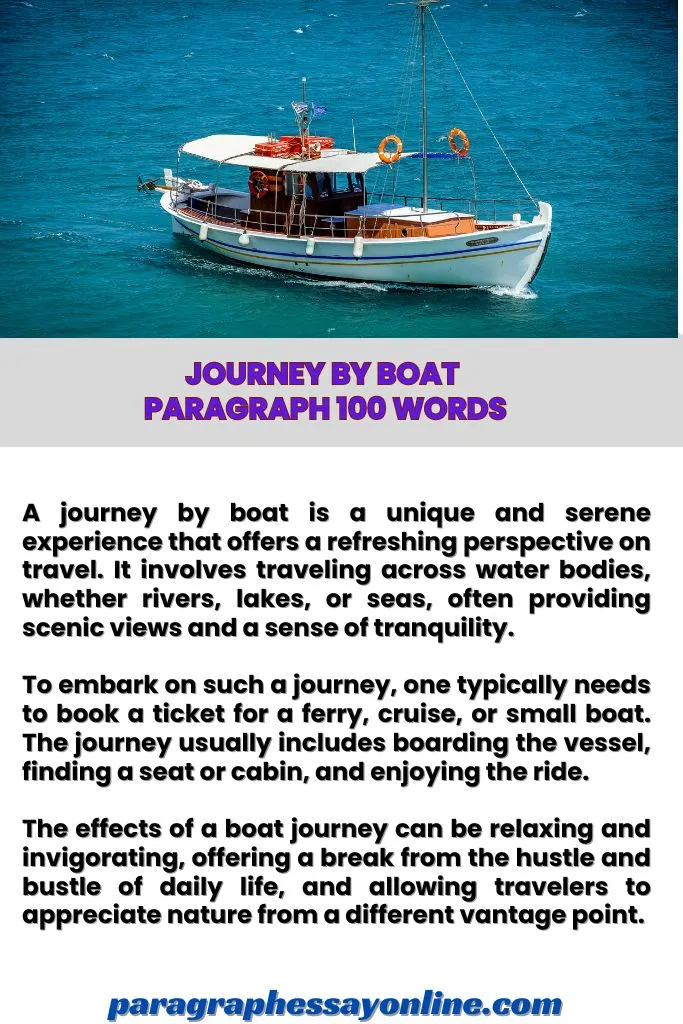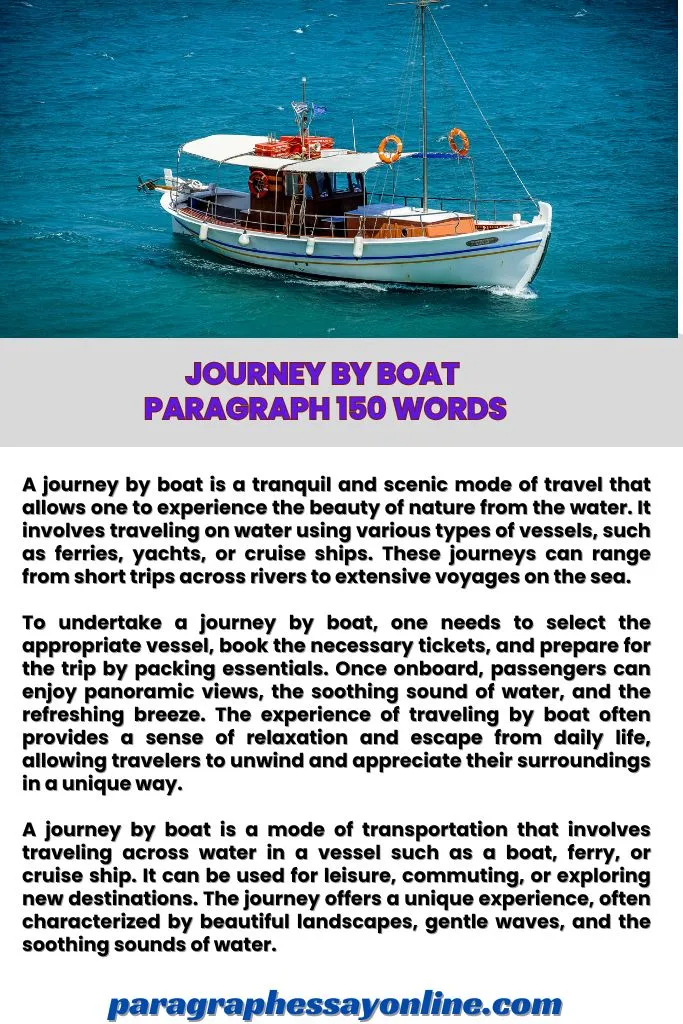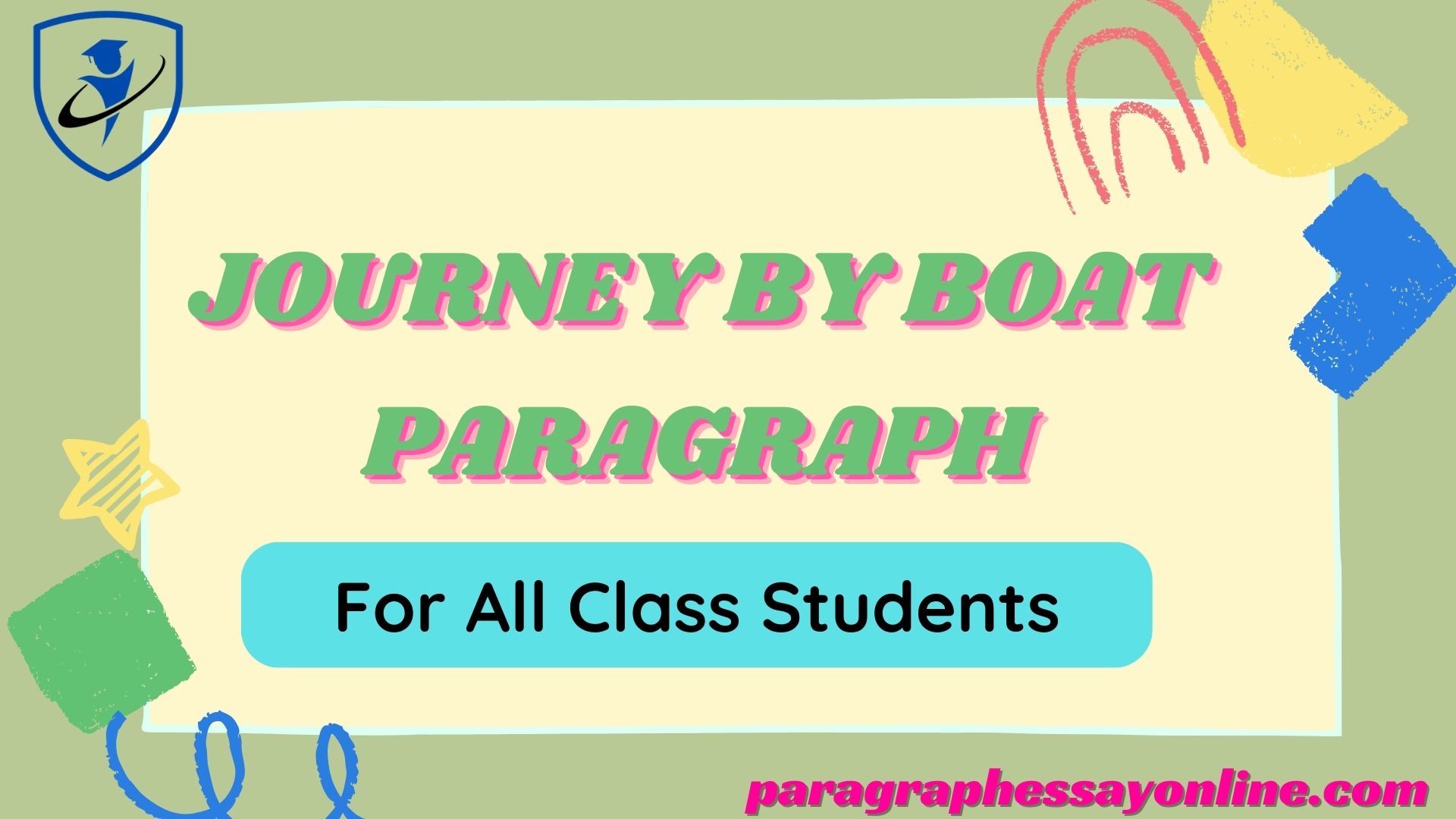Journey By Boat Paragraph
Journey By Boat Paragraph For All Classes (1-12)
Embarking on a journey by boat is not just a mode of transportation; it’s an educational voyage that offers students a unique perspective on India’s rich cultural heritage and natural landscapes. As students set sail on the country’s iconic waterways, they delve into a world of discovery, exploring historical landmarks, witnessing traditional rituals, and learning about the importance of environmental conservation.
Through immersive experiences and interdisciplinary learning, boat journeys provide students with valuable insights into India’s diverse culture, history, and ecology, fostering a deeper appreciation for their country’s heritage while nurturing essential academic skills.
Journey By Boat Paragraph 100 Words For 1, 2, 3 Students
A journey by boat is a unique and serene experience that offers a refreshing perspective on travel. It involves traveling across water bodies, whether rivers, lakes, or seas, often providing scenic views and a sense of tranquility. To embark on such a journey, one typically needs to book a ticket for a ferry, cruise, or small boat.
The journey usually includes boarding the vessel, finding a seat or cabin, and enjoying the ride. The effects of a boat journey can be relaxing and invigorating, offering a break from the hustle and bustle of daily life, and allowing travelers to appreciate nature from a different vantage point.

Paragraph On Journey By Boat 150 Words For 4 And 5 Students
A journey by boat is a tranquil and scenic mode of travel that allows one to experience the beauty of nature from the water. It involves traveling on water using various types of vessels, such as ferries, yachts, or cruise ships. These journeys can range from short trips across rivers to extensive voyages on the sea.
To undertake a journey by boat, one needs to select the appropriate vessel, book the necessary tickets, and prepare for the trip by packing essentials. Once onboard, passengers can enjoy panoramic views, the soothing sound of water, and the refreshing breeze. The experience of traveling by boat often provides a sense of relaxation and escape from daily life, allowing travelers to unwind and appreciate their surroundings in a unique way.
A journey by boat is a mode of transportation that involves traveling across water in a vessel such as a boat, ferry, or cruise ship. It can be used for leisure, commuting, or exploring new destinations. The journey offers a unique experience, often characterized by beautiful landscapes, gentle waves, and the soothing sounds of water.

Paragraph On Journey By Boat 200 Words For 6, 7, 8 Students
A journey by boat is a captivating and peaceful way to travel, offering an escape from the daily grind and a chance to connect with nature. Whether you’re navigating through calm rivers, crossing expansive lakes, or sailing on the open sea, this mode of travel provides unique experiences that cannot be replicated by land or air travel. The rhythmic motion of the boat, the sound of water lapping against the hull, and the expansive views create a serene and refreshing atmosphere. A boat journey can range from a short ferry ride to a multi-day cruise, each offering its own set of adventures and sights.
A journey by boat involves traveling across water using a vessel such as a ferry, yacht, or cruise ship. This form of travel can be used for various purposes including leisure, transportation, and exploration. It provides an immersive experience where travelers can enjoy the natural beauty of waterways, observe wildlife, and visit destinations that are often inaccessible by other means of transportation.
A boat journey can have numerous positive effects on travelers. The calming influence of water and the gentle sway of the boat can reduce stress and promote relaxation. The opportunity to disconnect from everyday routines and immerse oneself in nature can be rejuvenating, offering mental and emotional benefits.
Journey By Boat Paragraph 250 Words For 8,9,10 Students
A journey by boat is an enchanting and tranquil way to travel, providing a break from the usual routines of life and allowing for a deep connection with nature. Whether you’re gliding through serene rivers, crossing vast lakes, or sailing on the open sea, traveling by boat offers unique experiences and perspectives. The gentle rocking of the boat, the sound of water against the hull, and the panoramic views create a serene and rejuvenating atmosphere. Boat journeys can vary from short ferry rides to multi-day cruises, each promising its own adventures and sights, making it a memorable experience for all.
A journey by boat refers to traveling over water using various types of vessels such as ferries, yachts, or cruise ships. This form of travel is used for diverse purposes including leisure, transportation, and exploration. It provides an immersive experience where travelers can enjoy the natural beauty of water bodies, observe marine life, and reach destinations that might be inaccessible by land or air.
Traveling by boat can have numerous positive effects on individuals. The calming influence of the water and the gentle motion of the boat often help reduce stress and promote relaxation. The opportunity to disconnect from the fast-paced routine of daily life and immerse oneself in the natural surroundings can be refreshing and mentally rejuvenating. Travelers often feel more reflective and connected to their environment, enjoying a slower, more contemplative pace. Additionally, boat journeys can create strong social bonds, as shared experiences on the water foster camaraderie and create lasting memories among travelers.
Journey By Boat Paragraph 300 Words For 9, 10, 11, 12 Students
A journey by boat is a captivating and peaceful form of travel that offers an escape from the mundane routines of everyday life. It allows travelers to connect deeply with nature, whether they are drifting along tranquil rivers, crossing expansive lakes, or navigating the open sea. The gentle rocking of the boat, the soothing sounds of water lapping against the hull, and the unobstructed panoramic views create a calming and rejuvenating atmosphere. Boat journeys can range from short, scenic ferry rides to extended cruises that span multiple days. Each type of journey promises its own set of adventures, sights, and experiences, making it a memorable way to travel.
A journey by boat involves traveling over water using various types of vessels, such as ferries, yachts, or cruise ships. This form of travel is utilized for leisure, transportation, and exploration. It offers an immersive experience, allowing travelers to enjoy the natural beauty of waterways, observe marine and bird life, and visit destinations that are often inaccessible by land or air. The unique perspective of seeing the world from water provides an unparalleled sense of serenity and adventure.
Traveling by boat can have numerous positive effects on individuals. The calming influence of the water and the gentle motion of the boat can significantly reduce stress and promote a sense of peace and relaxation. This type of travel allows for a break from the fast-paced nature of daily life, offering a chance to slow down, reflect, and appreciate the beauty of the natural world. The journey can be mentally rejuvenating, providing a refreshing change of scenery and a sense of adventure. Additionally, boat journeys can enhance social connections, as shared experiences on the water create lasting memories and strengthen bonds among fellow travelers. Overall, a journey by boat is more than just a means of transportation; it is a holistic experience that enriches both the mind and soul.
Journey By Boat Paragraph 500 Words For 9, 10, 11, 12 Students
A journey by boat is a captivating and serene mode of travel that provides an opportunity to escape the hustle and bustle of everyday life and immerse oneself in the tranquility of the water. Whether cruising along calm rivers, traversing vast lakes, or sailing across the open sea, traveling by boat offers a unique experience that engages the senses and soothes the soul. The gentle rocking motion of the boat, the rhythmic sound of waves against the hull, and the panoramic views of the surrounding landscapes create an atmosphere of relaxation and adventure. From short ferry rides to extended luxury cruises, each boat journey presents its own set of wonders and discoveries, making it an unforgettable experience for travelers of all ages.
A journey by boat entails traveling across water bodies using various types of vessels, such as ferries, yachts, or cruise ships. It serves multiple purposes, including leisurely exploration, transportation, and even commerce. Boat journeys offer a unique perspective of the world, allowing travelers to witness breathtaking natural scenery, encounter diverse marine life, and access remote destinations that are often inaccessible by land.
To embark on a journey by boat, one must follow a series of steps:
- Destination Selection: Determine the desired destination for the journey, considering factors such as distance, scenery, and attractions.
- Vessel Choice: Choose the appropriate type of boat for the journey, taking into account the duration of travel, onboard amenities, and personal preferences.
- Ticket Reservation: Secure tickets for the chosen boat journey in advance, especially during peak travel seasons or for popular routes.
- Preparation: Pack essential items for the journey, including clothing suitable for the weather, sunscreen, sunglasses, medications, and any necessary travel documents.
- Arrival at Port: Arrive at the designated port or embarkation point well ahead of the departure time to ensure a smooth boarding process.
- Boarding: Present tickets and identification, then proceed to board the boat according to instructions provided by the crew.
- Settling In: Locate the assigned seat, cabin, or accommodation on the boat and familiarize oneself with the onboard facilities and safety procedures.
- Enjoying the Journey: Once underway, take pleasure in the unique experience of traveling by boat, whether by admiring the scenery, engaging in onboard activities, or simply relaxing and soaking in the ambiance.
- Disembarkation: Upon reaching the destination, follow instructions for disembarking the boat safely and efficiently.
The experience of a boat journey can have profound effects on travelers:
- Relaxation and Rejuvenation: The gentle motion of the boat and the calming presence of water often induce a state of relaxation, allowing travelers to unwind and recharge.
- Connection with Nature: Being surrounded by water and natural landscapes fosters a deep connection with nature, providing opportunities for contemplation and appreciation of the environment.
- Adventure and Exploration: Boat journeys offer the thrill of exploration, with the possibility of encountering unique sights, wildlife, and cultures along the way.
- Social Interaction: Sharing a boat journey with fellow travelers can lead to meaningful social interactions, fostering friendships and creating lasting memories.
- Cultural Immersion: Boat journeys often involve visits to coastal towns, islands, or ports, providing insights into local cultures, traditions, and ways of life.
Overall, a journey by boat is not just a means of transportation but a transformative experience that enriches the mind, body, and spirit, leaving travelers with cherished memories that last a lifetime.
Most Important Paragraph:
| Event Paragraph, |
| Modern Gadgets Paragraph. |
| Hard Work Paragraph. |
| Causes Of Failure In English Paragraph. |
| Snake Paragraph. |
Frequently Asked Questions For Journey By Boat Paragraph
1. What are the educational benefits of a journey by boat for students?
Answer: A journey by boat offers students diverse learning opportunities, including cultural immersion, historical exploration, environmental education, and interdisciplinary learning.
2. How do boat journeys contribute to cultural understanding?
Answer: Boat journeys allow students to witness traditional rituals, interact with local communities, and explore historical landmarks, fostering empathy and cross-cultural appreciation.
3. What academic subjects are integrated into boat journey experiences?
Answer: Boat journeys integrate concepts from geography, history, environmental science, social studies, and language development, offering students a multidisciplinary learning experience.
4. What environmental lessons can students learn during boat journeys?
Answer: Students learn about the importance of river conservation, biodiversity preservation, and the impact of human activities on river ecosystems through hands-on observations and guided discussions.
5. How do boat journeys enhance academic skills?
Answer: Boat journeys provide opportunities for critical thinking, communication, collaboration, and problem-solving, as students engage in experiential learning activities and interact with diverse stakeholders.
6. Are boat journeys suitable for students of all ages?
Answer: Boat journeys can be tailored to suit students of various age groups, from elementary to high school, with educational content and activities adapted to their cognitive abilities and learning objectives.
7. What safety measures are in place during boat journeys?
Answer: Boat journeys adhere to safety regulations and guidelines, with trained staff and appropriate safety equipment provided to ensure the well-being of students throughout the journey.
8. How can schools incorporate boat journeys into their curriculum?
Answer: Schools can collaborate with educational tour operators, museums, and local communities to design boat journey experiences that align with academic standards and learning goals across multiple subjects.
9. What long-term impact do boat journeys have on students?
Answer: Boat journeys inspire students to become lifelong learners and responsible global citizens, fostering a deeper appreciation for their cultural heritage, natural environment, and interconnectedness with the world around them.
